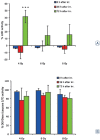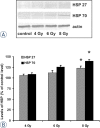Effect of ionizing radiation on human skeletal muscle precursor cells
- PMID: 24294183
- PMCID: PMC3814283
- DOI: 10.2478/raon-2013-0058
Effect of ionizing radiation on human skeletal muscle precursor cells
Abstract
Background: Long term effects of different doses of ionizing radiation on human skeletal muscle myoblast proliferation, cytokine signalling and stress response capacity were studied in primary cell cultures.
Materials and methods: Human skeletal muscle myoblasts obtained from muscle biopsies were cultured and irradiated with a Darpac 2000 X-ray unit at doses of 4, 6 and 8 Gy. Acute effects of radiation were studied by interleukin - 6 (IL-6) release and stress response detected by the heat shock protein (HSP) level, while long term effects were followed by proliferation capacity and cell death.
Results: Compared with non-irradiated control and cells treated with inhibitor of cell proliferation Ara C, myoblast proliferation decreased 72 h post-irradiation, this effect was more pronounced with increasing doses. Post-irradiation myoblast survival determined by measurement of released LDH enzyme activity revealed increased activity after exposure to irradiation. The acute response of myoblasts to lower doses of irradiation (4 and 6 Gy) was decreased secretion of constitutive IL-6. Higher doses of irradiation triggered a stress response in myoblasts, determined by increased levels of stress markers (HSPs 27 and 70).
Conclusions: Our results show that myoblasts are sensitive to irradiation in terms of their proliferation capacity and capacity to secret IL-6. Since myoblast proliferation and differentiation are a key stage in muscle regeneration, this effect of irradiation needs to be taken in account, particularly in certain clinical conditions.
Keywords: apoptosis; interleukin 6; irradiation; muscle regeneration; myoblasts; proliferation.
Figures




Similar articles
-
Ionizing radiation increases primary cilia incidence and induces multiciliation in C2C12 myoblasts.Cell Biol Int. 2015 Aug;39(8):943-53. doi: 10.1002/cbin.10462. Epub 2015 Apr 8. Cell Biol Int. 2015. PMID: 25808704
-
Cytokine response of cultured skeletal muscle cells stimulated with proinflammatory factors depends on differentiation stage.ScientificWorldJournal. 2013;2013:617170. doi: 10.1155/2013/617170. Epub 2013 Feb 20. ScientificWorldJournal. 2013. PMID: 23509435 Free PMC article.
-
Heat shock pretreatment enhances porcine myoblasts survival after autotransplantation in intact skeletal muscle.Sci China C Life Sci. 2007 Aug;50(4):438-46. doi: 10.1007/s11427-007-0065-6. Sci China C Life Sci. 2007. Retraction in: Sci China C Life Sci. 2008 Mar;51(3):286. doi: 10.1007/s11427-008-0042-8. PMID: 17653663 Retracted.
-
High dexamethasone concentration prevents stimulatory effects of TNF-alpha and LPS on IL-6 secretion from the precursors of human muscle regeneration.Am J Physiol Regul Integr Comp Physiol. 2006 Dec;291(6):R1651-6. doi: 10.1152/ajpregu.00020.2006. Epub 2006 Jul 20. Am J Physiol Regul Integr Comp Physiol. 2006. PMID: 16857895
-
Regulation of Skeletal Muscle Myoblast Differentiation and Proliferation by Pannexins.Adv Exp Med Biol. 2017;925:57-73. doi: 10.1007/5584_2016_53. Adv Exp Med Biol. 2017. PMID: 27518505 Review.
Cited by
-
Transcriptome Profiling Reveals Enhanced Mitochondrial Activity as a Cold Adaptive Strategy to Hypothermia in Zebrafish Muscle.Cells. 2023 May 11;12(10):1366. doi: 10.3390/cells12101366. Cells. 2023. PMID: 37408201 Free PMC article.
-
Irradiation of muscle precursor cells impairs the proliferative and angiogenic functions of their extracellular vesicles.Sci Rep. 2025 Aug 20;15(1):30563. doi: 10.1038/s41598-025-15699-x. Sci Rep. 2025. PMID: 40835994 Free PMC article.
-
Electrical Stimulation for Treatment of Dysphagia Post Head Neck Cancer: A Systematic Review and Meta-Analysis.Int Arch Otorhinolaryngol. 2023 Sep 14;28(2):e339-e349. doi: 10.1055/s-0043-1761175. eCollection 2024 Apr. Int Arch Otorhinolaryngol. 2023. PMID: 38618607 Free PMC article. Review.
-
The effect of radiation dose on mouse skeletal muscle remodeling.Radiol Oncol. 2014 Jul 10;48(3):247-56. doi: 10.2478/raon-2014-0025. eCollection 2014 Sep. Radiol Oncol. 2014. PMID: 25177239 Free PMC article.
-
Chemoradiation impairs myofiber hypertrophic growth in a pediatric tumor model.Sci Rep. 2020 Nov 11;10(1):19501. doi: 10.1038/s41598-020-75913-w. Sci Rep. 2020. PMID: 33177579 Free PMC article.
References
-
- Chargé SB, Rudnicki MA. Cellular and molecular regulation of muscle regeneration. Physiol Rev. 2004;84:209–38. - PubMed
-
- Austin L, Bower J, Kurek J, Vakakis N. Effects of leukaemia inhibitory factor and other cytokines on murine and human myoblast proliferation. J Neurol Sci. 1992;112:185–91. - PubMed
-
- Serrano AL, Baeza-Raja B, Perdiguero E, Jardí M, Muñoz-Cánoves P. Interleukin-6 is an essential regulator of satellite cell-mediated skeletal muscle hypertrophy. Cell Metab. 2008;7:33–44. - PubMed
LinkOut - more resources
Full Text Sources
Other Literature Sources
